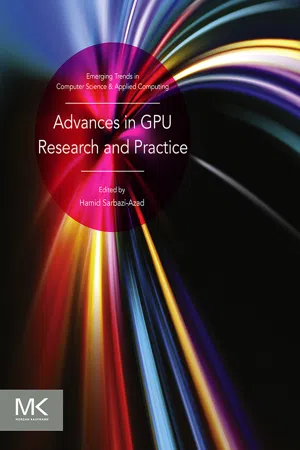
- 774 pages
- English
- ePUB (mobile friendly)
- Available on iOS & Android
Advances in GPU Research and Practice
About This Book
Advances in GPU Research and Practice focuses on research and practices in GPU based systems. The topics treated cover a range of issues, ranging from hardware and architectural issues, to high level issues, such as application systems, parallel programming, middleware, and power and energy issues.
Divided into six parts, this edited volume provides the latest research on GPU computing. Part I: Architectural Solutions focuses on the architectural topics that improve on performance of GPUs, Part II: System Software discusses OS, compilers, libraries, programming environment, languages, and paradigms that are proposed and analyzed to help and support GPU programmers. Part III: Power and Reliability Issues covers different aspects of energy, power, and reliability concerns in GPUs. Part IV: Performance Analysis illustrates mathematical and analytical techniques to predict different performance metrics in GPUs. Part V: Algorithms presents how to design efficient algorithms and analyze their complexity for GPUs. Part VI: Applications and Related Topics provides use cases and examples of how GPUs are used across many sectors.
- Discusses how to maximize power and obtain peak reliability when designing, building, and using GPUs
- Covers system software (OS, compilers), programming environments, languages, and paradigms proposed to help and support GPU programmers
- Explains how to use mathematical and analytical techniques to predict different performance metrics in GPUs
- Illustrates the design of efficient GPU algorithms in areas such as bioinformatics, complex systems, social networks, and cryptography
- Provides applications and use case scenarios in several different verticals, including medicine, social sciences, image processing, and telecommunications
Frequently asked questions
Information
Formal analysis techniques for reliable GPU programming
current solutions and call to action
2 University of Utah, Salt Lake City, UT, United States
3 dividiti, Cambridge, United Kingdom
4 Microsoft Research, Redmond, WA, United States
Abstract
Keywords
Acknowledgments
1 GPUs in Support of Parallel Computing
Bugs in parallel and GPU code
2 A quick introduction to GPUs
Table of contents
- Cover image
- Title page
- Table of Contents
- Copyright
- Dedication
- List of Contributors
- Preface
- Acknowledgments
- Part 1: Programming and Tools
- Part 2: Algorithms and Applications
- Part 3: Architecture and Performance
- Part 4: Power and Reliability
- Author Index
- Subject Index